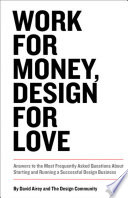

The book emphasizes that while earning a living is essential, the true fulfillment in work comes from passion and love for what you do. It argues that when you find a balance between making money and pursuing your creative interests, you achieve a more satisfying career. Passion fuels creativity and innovation, leading to better outcomes in both personal satisfaction and professional achievements. The authors share personal anecdotes and case studies that illustrate how successful individuals have navigated their careers by following their passions. They encourage readers to explore their interests and integrate them into their work life, suggesting that this alignment not only enhances job satisfaction but also leads to greater productivity and success.
Continue readingDesign is presented as a critical component of any successful business. The authors argue that design is not just about aesthetics; it’s about problem-solving and creating meaningful experiences for users. Good design can differentiate a product in a crowded market, enhance user engagement, and drive customer loyalty. The book provides examples of companies that have thrived by prioritizing design in their products and services. It also discusses the importance of understanding user needs and incorporating feedback into the design process, which is essential for creating products that resonate with consumers. This idea encourages readers to view design as an integral part of their business strategy rather than a secondary consideration.
Continue readingOne of the core themes of the book is the tension between commercial success and maintaining creative integrity. The authors discuss how many creative professionals struggle with the pressure to conform to market demands while wanting to stay true to their artistic vision. They argue that it is possible to achieve both by finding a niche that allows for creative expression while also being commercially viable. The book provides strategies for navigating this balance, such as identifying target audiences, creating unique value propositions, and leveraging personal branding. This discussion is particularly relevant for freelancers and entrepreneurs who often face the challenge of aligning their creative pursuits with financial stability.
Continue readingNetworking is highlighted as a vital aspect of career development in the creative industries. The authors stress that building relationships with peers, mentors, and clients can lead to new opportunities and collaborations. They provide practical advice on how to effectively network, including attending industry events, leveraging social media, and nurturing existing connections. The book emphasizes the importance of authenticity in networking, suggesting that genuine relationships are more beneficial than superficial contacts. By fostering a strong professional network, individuals can enhance their visibility in their field and open doors to new projects and partnerships.
Continue readingContinuous learning is presented as essential for staying relevant in a rapidly evolving job market. The authors advocate for a growth mindset, encouraging readers to embrace lifelong learning through various means such as formal education, online courses, workshops, and self-directed study. They discuss how the creative landscape is constantly changing due to technological advancements and shifting consumer preferences, making it crucial for professionals to adapt and expand their skill sets. The book includes resources and recommendations for further learning, emphasizing that investing in personal and professional development can lead to greater career satisfaction and opportunities.
Continue readingThe authors address the fear of failure that often holds creative professionals back. They argue that failure should be viewed not as a setback but as a valuable learning experience. By sharing their own failures and the lessons learned from them, the authors encourage readers to take risks and experiment in their work. The book provides strategies for reframing failure, such as conducting post-mortems on unsuccessful projects to identify what went wrong and how to improve in the future. This perspective fosters resilience and innovation, as individuals become more willing to push boundaries and pursue ambitious goals.
Continue readingThe importance of maintaining a healthy work-life balance is underscored throughout the book. The authors discuss the challenges that many creative professionals face in setting boundaries between work and personal life, particularly in an age where technology makes it easy to be constantly connected. They offer practical tips for creating a sustainable balance, such as setting specific work hours, prioritizing self-care, and learning to say no to projects that do not align with personal values or goals. The book emphasizes that a balanced lifestyle not only enhances personal well-being but also contributes to greater creativity and productivity in work.
Continue reading